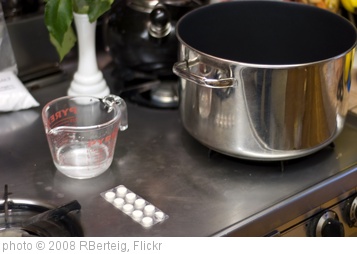there are a few other cloth diapering goods that we use on a regular basis, that help make CD'ing much easier.
wipes - some people use disposable wipes while they cloth diaper. to me, it just makes sense to use cloth wipes for the same reasons we use cloth diapers: to save money, make less trash, etc. plus, its natural to just throw the wipe into the diaper after you are done and throw all of that into the diaper pail.
you can purchase cloth wipes, but i find them to be way over priced. we have made all of our wipes. most people have lots of extra receiving blankets laying around. these cut up nicely for use as wipes (four to six inch squares work well). you don't even need to hem the edges. if you don't have extra receiving blankets, you can do the same thing with flannel bought from the fabric store.
to make a wipes solution, i take an old plastic wipes container, put about a tablespoon of dr bronner's in the bottom, add a few drops of tea tree essential oil, and fill about a third of the way with water. then stuff as many cloth wipes in as you can fit. this amount of wipes will last us about a week (for two in diapers).
its hard to say how many wipes we have. really, we have too many. i would guess somewhere in the range of 60-100, which is enough to fill two wipes containers completely full, although we usually only keep one full at a time.
snappies - we use snappies to fasten our prefold diapers. snappies are similar to ace bandage clips: they have small "teeth" that dig into the fabric to hold it together. you can kinda get away with not fastening prefolds (if you don't fasten them the diaper cover holds them in place a bit, but they might shift around on very mobile babies.) but snappies are inexpensive and worth the cost. we have three snappies for two babies (although about half our diaper stash are fitted that don't require snappies) which seems to be enough.
covers - we have tried 5 different brands of covers, but the only one i will mention is thirsties, because it is by far our favorite and a pretty good price. we own thristies snap and velcro covers, and the snap covers are much better (they hold more securely, plus you don't have to worry about the velcro wearing down.) we have about 8 or 9 small covers and 5 or 6 small covers. you will want more small covers than larger ones, as infants have messier (and more frequent) diapers than older babies. in fact, for newborns, 8 or 9 almost isn't even enough (depending on how often you do the laundry).
diaper pail/liner - our diaper pail is just a normal trash can that i bought from target (the kind that you opens when you step on the pedal). i bought the cheapest one there and now i wish i had gotten a nicer one because the pedal no longer works (though this is probably a combination of kiddos playing with it when i'm not looking and shoddy manufacturing)
our diaper pail liners are "planet wise" brand. for about a year we only had one liner but now we have two, which is helpful because there is always a clean one to put in right after you put a load in the wash. the material is water resistant, which helps keep the moisture in the bag.







